"Whereas all the taverns and alehouses of this city be used to be kept by young women otherwise than is used by any other place of this realme. To escrew wantoness, braws, frays and other inconveniences, it is ordered that after 9th June next, no tavern or alehouse be kept in the said city by by any woman between fourteen and forty years of age, under pain of forty pounds forfeiture for him or her that keepeth any such servant". Order of the Mayor of Chester 1540 |
Northgate
Street: Writing in 1856, the Chester antiquarian, author and guide, Thomas Hughes commented that inns and taverns in Northgate Street were "as plentiful as blackberries"- hence the inordinate length of this page- entirely devoted to one street!
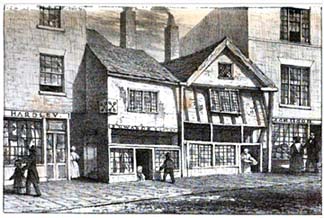 • The Cross Keys Tavern. Mentioned in the Cheshire Sheaf as existing in 1649, and as being old even then. This inn was listed in Cowdroy's Directory in 1789 when the licencee was Vincent Evans. In 1818-22 Pigot's Directory gives the landlord as John Richards. In 1840 it was William Davies, in 1855 William Blain. • The Cross Keys Tavern. Mentioned in the Cheshire Sheaf as existing in 1649, and as being old even then. This inn was listed in Cowdroy's Directory in 1789 when the licencee was Vincent Evans. In 1818-22 Pigot's Directory gives the landlord as John Richards. In 1840 it was William Davies, in 1855 William Blain.
Writing in the 1850s, Thomas Hughes stated that, for a while there were in fact two inns called The Cross Keys facing each other across Northgate Street. The original (illustrated right) was at the northern- and long vanished- end of the ancient 'Brokenshins Row' (east side of the street). When its landlord moved into Shoemaker's Row opposite, he insisted on taking his sign with him, amending it, curiously, to read "The Old Cross Keys"!
Previous to the move, this inn had been called The Cross Foxes Tavern. It is listed as such in Cowdroy's Directory in 1782, its licencee being Richard Jackson and in Pigot's Directory 1818-20, licencee Miles Harrison, who was still there in 1828. The licencee of the original, 17 Northgate Street Row, was John Smith, in 1850-57 Mrs Sarah Smith, in 1858 William Davies, in 1871 Joseph Tushingham, in 1880 Emma Tushlington, in 1902 Miss Mary Smith.
The name changed again later, when The Cross Keys became The Masons Arms. Later still, there was a Masonic Arms, run by Emma Salmon, trading for many years on the eastern side of Northgate Street at number 28, in the vacinity of The Cross Keys. So it seems quite likely that: The Cross Keys ---> The Masons Arms ---> The Masonic Arms. (thanks to Jeff for this reasoning).
Emma Salmon had the Masonic in 1880, Henry Cordery from 1890 to 1895, in 1898 Joseph Carsley was there, in 1901/2 Rose Ellen Dew. She had lost her young husband Henry in 1883. Residents of Pyecroft Street, Handbridge, they had a taste for unusual names for their children; their daughters were called Morning, Evening, Mountain and May and their son Mynott King Hercules! In 1910 the licencee was Miss E Charmley, in 1914 Hugh Oldfield, in 1919-20 C Winder.
Another Cross Keys, after a period of decline and closure, is today again thriving on the corner of Lower Bridge Street and Duke Street.
• The Wolf's Head stood in the vicinity of Shoemaker's Row in the 17th century. The Wolf's head was the emblem of Hugh Lupus, Earl of Chester.
Doubtlessly also located in Shoemaker's Row was The Shoemaker's Arms. John Parry was the licencee in 1781, Mrs Parry in 1789.
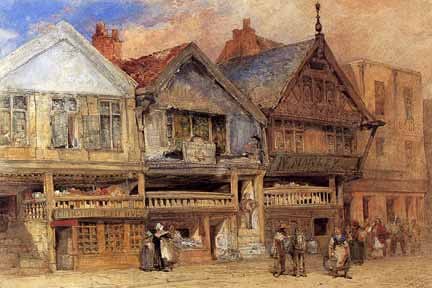 • The Three Crowns Inn formerly stood where Thomas Harrison's City Club or Commercial News Rooms stands today. An inn had existed here as far back as 1272 when Richard de Knaresburgh left his daughter a shop "near the inn which was Hugh Selimon's towards the church of St. Peter's". Nothing more is heard of it for 500 years until, in 1781, The Three Crowns' landlord was Thomas Lewis, who appears in Cowdroy's Directory for that year. In 1822-3 George Foster was the proprietor. In 1855, author and guide Thomas Hughes described the inn as having an old and picturesque gable front and that its chief entrance was from Shoemaker's Row. He also remarked that it had enjoyed its finest days long before it was eventually demolished, when its sign and licence were transferred to new premises in Pepper Alley- whose name was changed to The Bridgewater Tavern in 1831. • The Three Crowns Inn formerly stood where Thomas Harrison's City Club or Commercial News Rooms stands today. An inn had existed here as far back as 1272 when Richard de Knaresburgh left his daughter a shop "near the inn which was Hugh Selimon's towards the church of St. Peter's". Nothing more is heard of it for 500 years until, in 1781, The Three Crowns' landlord was Thomas Lewis, who appears in Cowdroy's Directory for that year. In 1822-3 George Foster was the proprietor. In 1855, author and guide Thomas Hughes described the inn as having an old and picturesque gable front and that its chief entrance was from Shoemaker's Row. He also remarked that it had enjoyed its finest days long before it was eventually demolished, when its sign and licence were transferred to new premises in Pepper Alley- whose name was changed to The Bridgewater Tavern in 1831.
• The Legs of Man.
Situated in Shoemaker's Row on the west side of the street. Advertisement from Adams’s Weekly Courant, 1 July 1788:
"P. CARTER, At the LEGS of MAN, Northgate-Street, CHESTER, BEGS Leave to acquaint the Public, that he has laid in an Assortment of Sweets, or British-made Wines, as Birch, Cowslip, Orange, and Raisin Wines, and Cyder of the best Quality, which will be sold on the most reasonable Terms,
By the Public’s most obedient Servant, P. CARTER".
This Peter Carter had been licencee since at least 1757. He was also a Verger at the Cathedral and lies buried in the south aisle of the nave. The inn's name derives from the Arms of the Stanley family, Earls of Derby, former Lords of the Isle of Man and longtime major landowners in Chester- 'Stanley Palace' still stands in Watergate Street.
This inn was listed in Cowdroy's Directory in 1789 as The Three Legs-of-Man, when the licencee was Peter Carter. The landlord in 1818 was Edward Noyes, in 1822-3 John Pierce and in 1828 it was Dublin Pearce. George Ankers is listed in the trades directory as landlord of the 'Legs of Man Tavern in Shoemaker's Row' in 1840 and his name appears on the inn's signboard in the centre of the illustration below, which dates from 1842. It shows Mr Ankers as the owner of the "Meeting House" at ground level. But seeing as George Ankers is listed in 1840 as being licencee of the Legs of Man in 1840, one can assume that he also ran the inn located above the "Meeting House" at this time.
The Legs of Man, as such, had its last mention in the trades directories in 1846 but, by 1850 the inn had changed its name to The Forester's Arms and is listed as such in the History, Gazetteer & Directory of Cheshire, 1850 when the licencee was Frederick Hooley. It appears in the watercolour below, painted in 1854, by the prolific and long-lived English artist William Callow (1812-1908).
The Chester Chronicle's Police Report of Saturday 12th April 1851 told of the licencee of the Forester's Arms, "better known as the Man, in Shoemaker's Row", being charged with "harbouring females of bad character there on Saturday night last"... Another Forester's Arms existed at this time somewhere in Boughton.
• The Sun Vaults (no 9) It was recorded as The Sun Tavern in 1675 but its name was changed by 1873. Slater's Directory 1855 has Edward Urmston in charge, The Post Office Directory of Cheshire in 1857 lists it simply as The Sun, licencee, as earlier, Mr Urmstom. The landlord in 1871 was William Parry and in 1898 William Rowlands. The inn finally closed in 1900 when the area was redeveloped. Located next door to The Legs of Man, it can be seen in Callow's painting above and on the far left of the illustration on the right.
The name of The Eagle and Child (recorded in 1740 as being at least two centuries old) in common with The Legs of Man above, derives from an ancient emblem of the Stanleys of Lathom. It has been conjectured that the Eagle & Child and the Legs of Man were in fact the same house under changing names. The last ever 'Minstrel's Court' was held here in 1757.
• The Hope & Anchor: "the fourth house south of King Street". Although a house on this site is mentioned in 1385 when it was owned by Henry de Burcheles, it
is first recorded as an inn in 1648 when John Anderson was the licencee. The Hearth Tax returns for 1664 show that the inn had "33 hearths"- more than double that of any other in the city so it must have been an establishment of considerable size and importance. By 1737, when it was last mentioned, its name had changed to The Golden Talbot and the landlady was Elizabeth Brereton. Its popularity seems to have declined rapidly after this date and no trace of it can be found in the 1782 directory. However, a Talbot Tavern is listed as trading in Northgate Street in Pigot's Directory for the years 1818-20, its licencee Catherine Trevor. And an inn by the name of The Anchor is recorded as trading in Northgate Street around the time the Hope & Anchor / Talbot disappeared, 1781. Its licencee was Mr Johnson.
A large private house eventually arose on the site which became the Judges' Lodgings before being occupied by a firm of solicitors. It was demolished to make way for the Odeon Cinema which opened in 1936- and, to the regret of all, closed in 2007.
• The Duke of Ormond's Head- exact location currently unknown but mentioned in a 1749 edition of the Chester Courant.
• The Golden Falcon Inn, standing close to the Northgate, was first recorded in 1704 and for many years considered the principal coaching inn of the city. It was tenanted for several generations by members of the Kenna family- and had been commonly referred to as Kenna's from at least 1711. Mrs Katherine Kenna, who died here in 1770 was the last of her line. It was here, in 1741, that the composer George Friderick Handel stayed for several days. Prevented by bad weather from sailing for Ireland from the small port of Parkgate on the Wirral, he was forced to assemble a makeshift orchestra and chorus from the Cathedral and elsewhere to rehearse what would be, when he eventually arrived in Dublin, the first performance of his best-loved work, Messiah. More anecdotes of notable events at the Golden Falcon, including the curious tale of 'Jarvis's money', may be found here.
An even older inn, the White Bull, mentioned in 1642, was incorporated into the Golden Falcon in 1752. In 1763 it was acquired and partially rebuilt by George Smith, who also owned Chester's grandest coaching inn, The White Lion- of which more below- which once stood where the mediocre development of shops and council offices, known as The Forum is now. But the great days of the Falcon had passed away with the last of the Kenna family and, in spite of the improvements carried out by George Smith, custom diminished and the career of the inn as such came to an end and the premises were put to other uses. By 1772, this former Row had become a vinegar manufactory until George Eaton bought and eventually demolished all the properties on the site to build his brewery. His son, Peter Eaton expanded the business and served as Mayor of Chester in 1856-7.
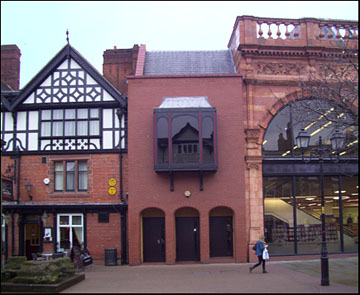 On the subject of coaching inns, aside from the just-mentioned Golden Falcon and White Lion, the other Chester establishments that were involved in this trade were the nearby, and still-thriving Pied Bull, The Coach & Horses- now The Coach House- in the Market Square, The Feathers Inn in Bridge Street and The Blossoms Inn on the corner of Foregate Street and Love Street. Goods traffic in those old days was operated by a system of pack horse trains which could be seen along nearby Upper Northgate Street and Liverpool Road, waiting to be hired and loaded. On the subject of coaching inns, aside from the just-mentioned Golden Falcon and White Lion, the other Chester establishments that were involved in this trade were the nearby, and still-thriving Pied Bull, The Coach & Horses- now The Coach House- in the Market Square, The Feathers Inn in Bridge Street and The Blossoms Inn on the corner of Foregate Street and Love Street. Goods traffic in those old days was operated by a system of pack horse trains which could be seen along nearby Upper Northgate Street and Liverpool Road, waiting to be hired and loaded.
No reference to the Golden Falcon occurs in the 1782 directory and the building was then in the occupation of "John Tomlinson, surgeon". Thirteen years later, 1795, the premises are listed as in the occupancy of "Messrs, Tomlinson, Brewers, Northgate Street".
A new brewery was built on the site in the 1850s. Eaton's Brewery eventually took over the Kelsterton and St. Winnifred's (Holywell) breweries and the company was bought out in 1864 by Henry Ford, Frederic Gunton and William Kelly, who formed the Northgate Brewing Company in 1889. They had 'bottling stores, wine and spirit vaults' at 7 Foregate Street and malt kilns on the east side of Lower Bridge Street and owned pubs throughout Cheshire and North Wales. The brewery was again taken over, in 1949, by Warrington-based Greenhall Whitley, who closed it down twenty years later and the buildings were demolished in 1971. A large and unsympathetic office building, Centurion House, now occupies the site. See our illustrated feature on the Northgate Brewery here.
• The Hart- location currently unknown but recorded as being used as a polling station in 1809.
 • The Elephant & Castle Inn: Licencee 1782 George Johnson, in 1785 Absalom Ray (Cowdroy's Directory), in 1789 Mrs Johnson, in 1818-20 Bathia Rogerson (Pigot's Directory), in 1822-3 B Goody, in 1828 George Price, in 1840 John Moult, in 1846-57 Thomas Reeves, in 1857 Thomas J Richards, in 1871-3 Peter and Ellen Dale, in 1880 Thomas Pulford. • The Elephant & Castle Inn: Licencee 1782 George Johnson, in 1785 Absalom Ray (Cowdroy's Directory), in 1789 Mrs Johnson, in 1818-20 Bathia Rogerson (Pigot's Directory), in 1822-3 B Goody, in 1828 George Price, in 1840 John Moult, in 1846-57 Thomas Reeves, in 1857 Thomas J Richards, in 1871-3 Peter and Ellen Dale, in 1880 Thomas Pulford.
In the 1881 census the building is described as a “spirit vault” run by Dessimus Webster and his wife Ellen. In 1891-1900 the licencee was Mrs Mary Anne Evans, 1900 to at least 1920 Thomas Hulse. Around 1925 the licence was withdrawn it became The Town Hall Cafe and was still so in 1945.
An inn on this site was first mentioned in 1533. It long bore the name of The Chequers but this had changed to The Elephant & Castle by the time George Johnson had it in 1782. It appeared in the polling station list in 1809. It stood between the still-thriving 300-year old Coach & Horses (rebuilt in the 19th century and recently renamed 'The Coach House') and Mr Hewitt's Coach Works, later also rebuilt and renamed as The Westminster Coach Works, the ornate facade of which survives as part of Chester Library. On the left we see the Elephant & Castle, somewhat obscured behind a young tree, a small detail from a general view of the square from around 1905. The site is now occupied by a bland red brick structure (above, photographed by the author in in 2010) that forms the left-hand side of Chester Library. The Elephant & Castle now has its own page in our Lost Pubs of Chester gallery...
• The Black Lion- also mentioned in the polling station list. Listed in Pigot's Directory for the years 1818-20 when the licencee was E Norton, and in 1828/9, its licencee Edward Peters. In 1822-3 it had been Thomas Thelwell. It appears in the 1840, 1850 and 1855 Chester Trades Directories when its landlady in each case was Sarah Bishop, and the 1859 Post Office Directory of Cheshire, licencee Mrs S Terry. The inn does not appear in the 1871 directory.
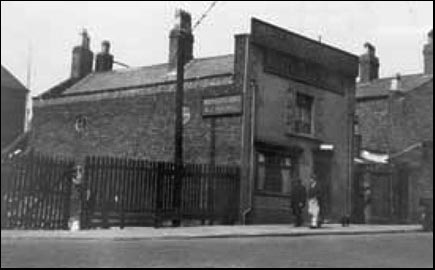 Right: The title attached to this image of a rather dilapidated pub calls it 'The Northgate Arms, 1930'. Is it the same inn that, in
1856 Thomas Hughes recorded as The Northgate Tavern, that was "a step or two northward of the Golden Falcon, occupying, indeed, a portion of the house just treated of". Licencee in 1818 Robert Woodfine, in 1822-3 William Williams, in 1828 John Wynne, in 1840 Thomas Denson, in 1850 James Ruscoe, in 1855 Edward Needles, in 1857 J Read, in 1871 Thomas Bailey, in 1898-1910 Mrs Ellen Briggs. Earlier, in 1880, Slater's Directory lists it as simply The Northgate, its licencee being William Lloyd. From 1914 to at least 1920 Loftus Hughes was the landlord. It may be seen in this detail of the 1875 Chester OS map. Right: The title attached to this image of a rather dilapidated pub calls it 'The Northgate Arms, 1930'. Is it the same inn that, in
1856 Thomas Hughes recorded as The Northgate Tavern, that was "a step or two northward of the Golden Falcon, occupying, indeed, a portion of the house just treated of". Licencee in 1818 Robert Woodfine, in 1822-3 William Williams, in 1828 John Wynne, in 1840 Thomas Denson, in 1850 James Ruscoe, in 1855 Edward Needles, in 1857 J Read, in 1871 Thomas Bailey, in 1898-1910 Mrs Ellen Briggs. Earlier, in 1880, Slater's Directory lists it as simply The Northgate, its licencee being William Lloyd. From 1914 to at least 1920 Loftus Hughes was the landlord. It may be seen in this detail of the 1875 Chester OS map.
• The Black Swan Inn.
These latter two inns attracted the attention of Thomas Hughes, writing in 1856, as follows: "Two doors higher up the street, we reach the den of the Black Lion, who frowns with an air of supreme indifference on his next door neighbour, the Black Swan. Of his sable majesty of the forest we have nothing to communicate, save that he presided over the destinies of this tavern at least as early as 1784. The Black Swan is a market inn of considerable antiquity, being described as an old one in 1750. Ten years afterwards, viz. on the 10th of May 1760, an extraordinary outrage was committed in this house, by a couple of troopers belonging to General Honeywood's Regiment of Horse, then quartered in this city. It was early morning, some hours before daybreak, and as one William Nevitt, of Hawarden, was coming out of a parlour of the Black Swan, one of these miscreants drew his broadsword, and, without any provocation, pursued Nevitt along the entry to the street door, where he severely wounded him about the head and body ; and, after cutting off a portion of the scalp and ear of his victim, delivered his sword to his companion, who made a forcible stroke at the head of poor Nevitt. the latter's arm getting broken in warding off the blow. The heroes, believing they had totally demolished an unarmed man, left him to his fate, and, going up stairs, the same morning made their escape. Strange to say, notwithstanding a reward was offered both by the War Office and the city, and thanks, in a great measure, to the splendid police system of those days, the retreat of these scoundrels was never discovered, and so the ends of justice were unhappily frustrated.
Apropos of the Swan, among a collection of Cheshire Tokens, in my possession, is one bearing the following inscription, extending over both sides : "John Hough, at the Swan in Chester, his halfpeny, 1666", but I incline to the belief that this has reference not to the house now under review, but to the White Swan, in Foregate Street, of which we may have to speak in a future portion of this Paper."
The Black Swan was listed in Pigot's Directory for 1828/9 when the licencee was John Evans, in the 1850 Chester Trades Directory, licencee John Hughes (he had been there in 1840), and the 1859 Post Office Directory of Cheshire, licencee George Jepson (Slater's lists him there in 1855). The inn is absent from the 1871 directory. ln 1772, John Salladine, landlord of the Black Swan, was tried at the City Sessions, and convicted of forgery. There was another Swan Inn in Forefate Street.
"To drink is a Christian diversion, Unknown to the Turk or to the Persian". William Congreve
Confusing one this. Next door to the Black Swan was The Fleece Inn, recorded as such being used as a polling station in 1809. Earlier, it had been listed in Cowdroy's Directory in 1789 as The Golden Fleece, its licencee being Edward Critchley. It later changed its name to The Stag's Head. It is listed as such in Pigot's Directory in 1818-20 when the licencee was Ralph Reese (although William Dickens is also listed as licencee during that time, appearing in a directory for 1822-3) and in 1828, licencee Charles Hughes, BUT it was also listed in the same, 1828, edition as The Fleece Tavern with the same landlord...
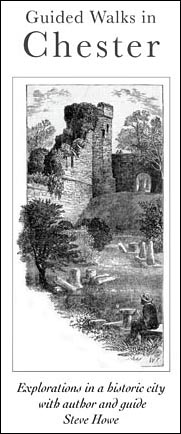 Confusingly, the Post Office Directory of Cheshire in 1857 still calls it The Fleece (landlord J Shaw) AND lists it as The Stag, licencee J Townsend... In 1822 John Rimmer was the licencee, in 1840 James Bentley, in 1850 it was Ann Bentley (his widow?) In 1871 it appears in the Chester Directory as The Stag Inn, landlord George Griffiths. In 1880, it is listed in a Cheshire Directory simply as The Stag and its licencee as Thomas Hall. In 1910 William Rutter was in charge, in 1919-20 H Hesketh. It was located at 74 Northgate Street. Confusingly, the Post Office Directory of Cheshire in 1857 still calls it The Fleece (landlord J Shaw) AND lists it as The Stag, licencee J Townsend... In 1822 John Rimmer was the licencee, in 1840 James Bentley, in 1850 it was Ann Bentley (his widow?) In 1871 it appears in the Chester Directory as The Stag Inn, landlord George Griffiths. In 1880, it is listed in a Cheshire Directory simply as The Stag and its licencee as Thomas Hall. In 1910 William Rutter was in charge, in 1919-20 H Hesketh. It was located at 74 Northgate Street.
In 1856, guide and author Thomas Hughes wrote of it as a "capital and recently-rebuilt inn" that stood immediately opposite the northern end of the Exchange (Chester's former Town Hall that long stood in the middle of the Market Square until burning down in 1862).
It was one of a number of properties in Chester to be subject to the Execution Rent. Execution Rent Tenants were bound to keep watch for the city on three nights in the year, namely on Christmas Eve, Christmas Day, and St. Stephen's Day (26th December) and they were bound to mount guard over and conduct felons and robbers as far as the gallows. For their services these tenants were "exempt from attendance on all inquisitions, juries and assizes, except when held before the Lord, the Prince and the Earl of Chester".
Speaking of the Exchange, the room on its NE corner, together with the cellar beneath, once formed an establishment by the name of The Exchange Coffee House- originally just that but, by the turn of the 19th century, serving as a tavern. While staying nearby in 1741, the composer Handel was known to partake of coffee and a pipe here. The Town Clerk later appropriated the upper room for use as an office but drinking continued beneath until the disastrous fire put an end to it.
Next to the Golden Fleece, and close to the corner of Princess Street, stood The Eastham Packet, named after the steamers which met the Chester canal packets and stage coaches at that place to convey their passengers across the Mersey to Liverpool. In 1818-23 its licencee was Isaac Beech, in 1850-57 Richard Leftwich. Named for doubtlessly similar reasons, The Dublin Packet continues to thrive at the south end of the Market Square today.
• The Hibernian Union. This unusually-named pub is listed in Pigot's 1828-1829 Directory, the licencee being Susanna Hulley.
• The City Arms stood on the corner of St. Werburgh Street. It was described by Hughes in the 1850s as "a wine vaults which, at the turn of the present century, served as a tavern." This inn was listed in Cowdroy's Directory in 1789 when the licencee was J Cleever. His listing goes on the state, "also goldsmith and jeweller, Eastgate Street". It changed its name to The Mason's Arms sometime before 1818. This appears in Pigot's Directory 1818-20 when its licencee was John Moss. He was still there in 1822-3. It reverting back to to The City Arms sometime between 1823 and 1828, then changed its mind again, became Johnsons Spirit Vaults sometime between 1829 and 1840. It appears as such in the 1871 census trading in Northgate Street East.
“Do not cease to drink beer, to eat, to intoxicate thyself, to make love, and to celebrate the good days.” Ancient Egyptian Creed
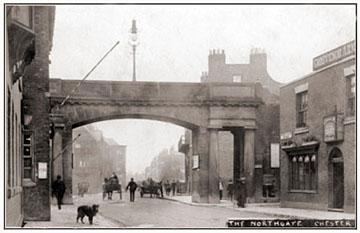 • The Grosvenor Arms. (no 132, east side, next to the Northgate). It can be seen on the right of our photograph, which was taken in 1907. An earlier, timber-built tavern stood on this spot in the 18th century
known as The Hen & Chickens which was said, in the words of Thomas Hughes, to "have reaped golden
harvests when, in the days of the old Northgate Prison, unfortunate malefactors
suffered, close to this spot, the last penalty of the law at the hands of
the public hangman". • The Grosvenor Arms. (no 132, east side, next to the Northgate). It can be seen on the right of our photograph, which was taken in 1907. An earlier, timber-built tavern stood on this spot in the 18th century
known as The Hen & Chickens which was said, in the words of Thomas Hughes, to "have reaped golden
harvests when, in the days of the old Northgate Prison, unfortunate malefactors
suffered, close to this spot, the last penalty of the law at the hands of
the public hangman".
The 'hen & chickens' is a Christian emblem of Divine Providence and the name may have been chosen by the ecclesiastical authorities at the Abbey- today's Cathedral- upon whose land the inn stood. It seems somewhat irreverent to have bestowed the name on an ordinary inn so it is possible the premises once served as accomodation for pilgrims who sought the hospitality of the Abbey.
This inn was listed by this name in Cowdroy's Directory in 1789 when the licencee was James Clinging who, curiously, appears a second time in Cowdroy's as licencee of The Wheat Sheaf. This was possibly a 'nickname'- the wheat sheaf being the insignia of the Grosvenor family- and was also one of the names by which the nearby Brown Cow on the corner of Dee Lane (Canal Street: see next entry) was known. The inn was later entirely rebuilt and renamed, becoming The Grosvenor Arms. In 1840 it is listed as The Grosvenor's Arms Inn, licencee Maria Harper. The licence was withdrawn in 1912 and the inn became a shop; it long housed a branch of Sayer's the Bakers. At the end of 2009, a delicatessen and restaurant expanded into there from their smaller premises next door. An art gallery now occupies the upper floor.
Licencees: 1706 Ellenor Kaye, 1782 James Clinging and John Davis, 1789 James Clinging, 1818-20 Mary Hall, 1822-3 Mary Ball (the same person misspelled?), 1840 Maria Harper, 1846 Thomas Jones, 1850 Henry Davies, 1857-60 Charles Whitlow, 1874 Kate Bradshaw, 1880 Kate Parker (the same Kate married?), 1898 Absalom Hayes (see reader Jacqueline Naylor's interesting letter about him under City Road on the previous page). He was still there in 1904.
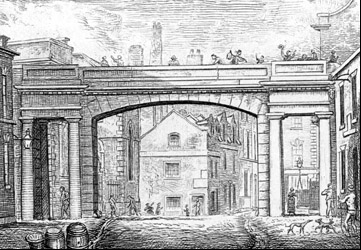
• The Brown Cow Inn (3 Upper Northgate Street) This public house stood on the corner of Upper Northgate St. and Dee Lane, later known as Canal Street. opposite the Blue Coat School and across the street from the still-thriving Bull & Stirrup.
It was known successively as The Chaise and Horses, between 1801 and 1808 as The Coach and Horses, The Brown Cow and The Wheat Sheaf, reverting to the name 'Brown Cow' some time before its sale to Chester Corporation in 1882. It was bought under powers bestowed on the Corporation by the Public Health Act, 1875, in pursuance of a scheme to widen and improve Canal Street and was later demolished when that occured in the 1880s. Its foundations and cellars doubtlessly still exist beneath the roadway.
In 1850-55 the licencee was Thomas Jones, in 1871 Henry Dixon, in 1880 its final landlord was Henry Dodd.
We can see the Brown Cow through the arch of the Northgate in this old drawing.
Returning briefly to The Bull & Strrup (7 Upper Northgate St); the fine building we know today was erected in late Victorian times but the inn was there long before that, being listed in Cowdroy's Directory in 1789 when the licencee was Jonathan Furber and in the 1859 Post Office Directory of Cheshire, licencee William Woodfin.
* Cowdroy's Directory in 1789 listed another Wheat Sheaf trading in "Further-Northgate-street", its licencee John Cheshire.
More cattle: The Dun Cow Tavern was in Upper Northgate Street in 1840, licencee Thomas Jones.
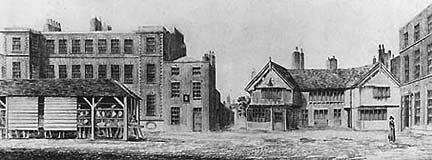 • The Crown & Grosvenor- in existence in 1744 (Cheshire Sheaf). Situated on the east side of Northgate Street, midway between the two abbey gateways, a pub was recorded as existing between 1751 and 1758 under the name of The White Hart Tavern. It was recorded as being used as a polling station in 1809. Its licencee in 1818-20 (Pigot's Directory) was Joyce Hall (but Martha Jones was also listed as landlady during this time), in 1822-3 Margaret Jones, in 1828 Robert Williams (but Pigot's Directory also says John Bateman), in 1840 Henry Knight, in 1850 (when it was still The White Hart) Joseph Lee. In 1855 (ditto White Hart) Samuel Lloyd. By 1871, its name had changed to The Stag Inn (74 Northgate Street) and George Griffiths was licencee that year. It still bore that name in 1902 when the landlord was William Rutter. In 1914 it was Henry Hales. • The Crown & Grosvenor- in existence in 1744 (Cheshire Sheaf). Situated on the east side of Northgate Street, midway between the two abbey gateways, a pub was recorded as existing between 1751 and 1758 under the name of The White Hart Tavern. It was recorded as being used as a polling station in 1809. Its licencee in 1818-20 (Pigot's Directory) was Joyce Hall (but Martha Jones was also listed as landlady during this time), in 1822-3 Margaret Jones, in 1828 Robert Williams (but Pigot's Directory also says John Bateman), in 1840 Henry Knight, in 1850 (when it was still The White Hart) Joseph Lee. In 1855 (ditto White Hart) Samuel Lloyd. By 1871, its name had changed to The Stag Inn (74 Northgate Street) and George Griffiths was licencee that year. It still bore that name in 1902 when the landlord was William Rutter. In 1914 it was Henry Hales.
An inn on the site of the still-thriving Shropshire Arms was at various times called The Crown (1741), The Crown & Mitre (1744-98), The Mitre Tavern (1817, illustrated left in this view by Batenham. The sign above the door reads "Hall, Mitre Tavern, Ale & Porter"). This inn was recorded as The Mitre in Cowdroy's Directory in 1789 when the licencee was Mrs Adams. In 1817 it was Thomas Hall, verger at the Cathedral and in 1822-3 D Nutting was the proprietor.
Referring again to The Crown & Mitre, an earlier reference to it apprears in Robert Freke Gould's The Four Old Lodges (1879) where it is listed as being a Masonic Lodge meeting place in the year 1724.
The inn changed its name to The Liverpool & Shropshire Inn (recorded as such in Slater's Directory 1855 and by author and guide Thomas Hughes in 1856). The object of this last change was to attract custom from the Shropshire Union Canal, then conveying passengers to and from Liverpool etc. The licencee in 1840, when it was called The Liverpool and Shropshire Arms Tavern was John Lowe. The landlady in 1846 was Ann Lowe. In 1850 the licencee was Jonathan Jones. Henry Jackson had taken over by 1855 (when the place was called The Liverpool and Shropshire Inn) and was still there in 1871. The Chester Directory for this year calls the inn Shropshire House. In 1880 the licencee was William Jackson. The inn is listed in Slater's Directory for this year as The Liverpool & Shropshire House. It was rebuilt soon after and in 1902 was being run by Thomas Hall. The first record of the inn being called The Shropshire Arms was in Kelly's Directory in 1910 when the licencee was Peter Coyle. In 1934 it was J Newnes.
• The Canal Packet House (Upper Northgate Street) - recorded as being used as a polling station in 1809. Listed in Pigot's Directory for 1828/9 when the lcencee was Mercy Adams.
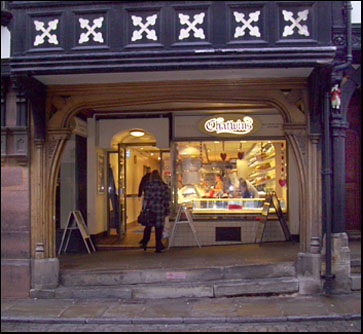 • The Woolpack Inn (27 Northgate Street- 'Shoemaker's Row': illustrated right). After it closed, the Woolpack became Sidoli's Restaurant, then Weinholt's Bakery, now Chatwin's Bakery. Our photograph, showing it as such, was taken by the author in 2010. • The Woolpack Inn (27 Northgate Street- 'Shoemaker's Row': illustrated right). After it closed, the Woolpack became Sidoli's Restaurant, then Weinholt's Bakery, now Chatwin's Bakery. Our photograph, showing it as such, was taken by the author in 2010.
The Woolpack had long had theatrical associations (and doubtlessly patrons), being situated close to the long-lost Music Hall- in fact previously being called The Shakespeare Tavern. It is recorded as such in Pigot's Directory for the years 1818-20, licencee Thomas Hughes. The landlord in 1822 was George Wooley, in 1n 1840, when it was The Woolpack Tavern, Thomas Mansergh, in 1850 Thomas Porter, in 1855-7 Robert Smith, in 1871 Thomas Porter, in 1880 Henry S Hewitt, in 1902 James Steele, in 1910-1920 J P Hankins, in 1935/6 Mrs Jane Singleton.
The Woolpack was recorded as being used as a polling station in 1809. A rather fuzzy, early photograph of it may be seen in our gallery.
"For dronkennesse is verray sepulture, Of mannes wit and his discrecioun". Chaucer
• The Dublin Castle (35 Upper Northgate Street, demolished for Inner Ring Road construction). Thomas Hughes spoke of it in 1856 as "a respectable tavern, even in our own day, but one which, even a century ago, enjoyed a far higher status than it now pretends to... then and now the "first and last" tavern on the once-great highway between Chester and Dublin. While at its portal, many a traveller stopped to have "another cup- and then", warm inside as well as out, set forth to brave the elements on his cheerless journey between Chester and Parkgate."
The licencee in 1818 was J Weigh (Pigot's Directory places it in 'Fore Northgate-street'), in 1828 William Evans, who was still there in 1850. A Chester trades directory of 1840 lists him thus, "bricklayer and Dublin Castle Tavern" and his inn as in 'Fore Northgate Street'. Sarah and Ann Evans were in charge in 1855 and, in 1857 the proprietor was R Wilkes, in 1871-80 John Matthew Baynes, in 1902 George Moss Jones, who was still there in 1920.
The site of this venerable inn now lies somewhere beneath the Fountains Roundabout on Chester's Inner Ringroad.
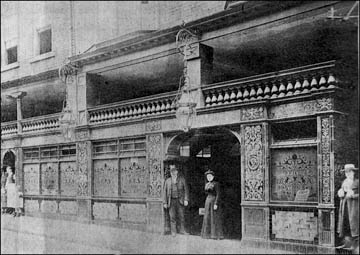 • The Ship
& Turtle: near The Cross. Later part of Quaintways nightclub. The attractive (and very vunerable) stained glass windows of the old Ship
& Turtle are
now part of Rosie's nightclub. Quaintways, run by entepreneur Gordon Vickers, who also long owned the Mill Hotel next to the Shropshire Union Canal in Milton Street, is fondly remembered by many local people due to the high quality of live music presented there, ranging from dance orchestras, jazz- the Walled City Jazz Band being residents for many years- and, throughout the 1970s, major bands such as Thin Lizzy, Status Quo, Dire Straights, Uriah Heep, Family, Judas Priest, Parliament/Funkadelic, Bad Finger, Long John Baldry’s Steam Packet (with Judy Driscoll,Vocals, Elton John, keyboards, a young Rod Stewart fronting) and the Sex Pistols, to mention just a few.
Those were the days. • The Ship
& Turtle: near The Cross. Later part of Quaintways nightclub. The attractive (and very vunerable) stained glass windows of the old Ship
& Turtle are
now part of Rosie's nightclub. Quaintways, run by entepreneur Gordon Vickers, who also long owned the Mill Hotel next to the Shropshire Union Canal in Milton Street, is fondly remembered by many local people due to the high quality of live music presented there, ranging from dance orchestras, jazz- the Walled City Jazz Band being residents for many years- and, throughout the 1970s, major bands such as Thin Lizzy, Status Quo, Dire Straights, Uriah Heep, Family, Judas Priest, Parliament/Funkadelic, Bad Finger, Long John Baldry’s Steam Packet (with Judy Driscoll,Vocals, Elton John, keyboards, a young Rod Stewart fronting) and the Sex Pistols, to mention just a few.
Those were the days.
Another Ship traded in Upper Northgate Street in the early 18th century. During the course of a discussion about prizes at Chester Races, the Cheshire Sheaf records, "On April 23,1705, the Minutes of the Company of Cappers, Pinners, Wire Drawers, and Linen Drapers record that "Whereas for some time past we have given money to the Mayor for his time, being towards several plates to be runn for at the Roody, butt finding our selves agrieved, it is therefore concluded and fully agreed, that henceforward there shall not any money be given towards any plate whatsoever". The Brethren seem to have relented, as we find them later, March 18th 1708, at Widow Crichley's at Ye Ship in fore Northgate Street, discussing giving moneyfor that very same purpose; "Spent at ye Ship in Ffurnorg'te St., ab't giving Mony to St. George's Plate 5s More, given to ye Plate 5s".
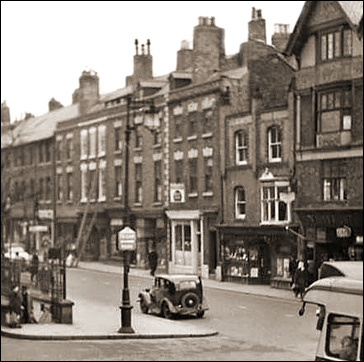 • The Muggeries (illustrated left) was a previous ale house on this site. The gentleman in the photograph is Mr William Higginson who was licencee from 1898 to 1905. Standing with him is Miss M Campbell who ran a cake shop above The Muggeries. William left here for The Duke of York in Frodsham Street in 1906 and then, in 1910, to the Castle Inn in Nicolas Street. • The Muggeries (illustrated left) was a previous ale house on this site. The gentleman in the photograph is Mr William Higginson who was licencee from 1898 to 1905. Standing with him is Miss M Campbell who ran a cake shop above The Muggeries. William left here for The Duke of York in Frodsham Street in 1906 and then, in 1910, to the Castle Inn in Nicolas Street.
We have found a record of one Frank Onions (1888-1937), who, between 1915 and 1920 served as "cellarman at Walker & Knights, aka The Muggeries, in Northgate Street".
We would love to know how the pub got its name (and also if Frank really "knew his onions"!) The only references to 'muggeries' we can find being another way of saying 'muggings'...
Was their ale that expensive? We know a few places like that today. A larger version of this photograph is in our gallery.
• The Bull's Head Tavern (no 58a, opposite the still-thriving Shropshire Arms). Landlord in 1818-1828 Thomas Moss, in 1840 Susan Williams, in 1850 George Jones, in 1851-71 John Horton, in 1880 James Kerns, in 1898 William King.
Referring back to John Horton, his Great Great Grandson, Colin P Horton, wrote to tell us, "John Horton (1818-1893) became a Freeman of Chester in 1839 by right of birth and appeared in the 1851 census as 'Inn Keeper, Bulls Head Tavern 58a Northgate Street'. He later moved to 63 Frodsham Street where he set up Horton's Vaults, which passed to his son on his death in 1893 (my Great Grandfather, also John Horton)."
The inn may be seen, immediately above the parked car, in this old photograph of Town Hall Square. Notice also the underground public toilets opposite.
• The White Lion Hotel, which stood for centuries on the west side of the Market
Square, an area long known as The Fish Market, where the entrance to the Forum shopping precinct
is now, was Chester's foremost and, by the standards of the day, most luxurious,
coaching inn. Stages long departed from its door to London, Ireland and all parts of the kingdom. Its landlord in 1605 had been William Pugh. Later came William Higginson, whose will in 1726 left it to his wife Elizabeth. The Higginsons ofChester were connected with the brewing and retailing of beer within the city for more than a century. Later, the Smith family long dominated. George Smith (see below) developed the coaching services and his sons William and Daniel, each in turn landlords of the White Lion, served as Sheriff of Chester in 1740 and 1765 respectively. A Mr Ellis was the licencee in 1781- as, it seems, was one J Hart. It is listed in Cowdroy's Directory in 1782, its licencee then being John Paul. Thomas Austin was the licencee in 1807 (see below), in 1817 it was Mercy Tomlinson (who would take over the Feathers Inn in Bridge Street in 1822), in 1850 Thomas Howell and in 1855-7 Peter Hilton. The venerable White Lion is absent from subsequent directories- unsurprisingly, as the splendid, and still much-missed, Market Hall was built on its site in 1863.
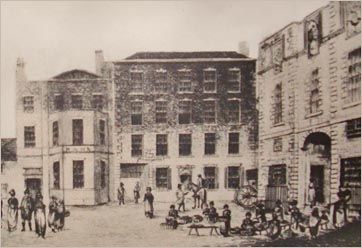 Returning briefly to Mr George Smith, the Lion's 18th century landlord and coach promoter. When he died, he was laid in a lead coffin and buried in in the churchyard of St. Oswald's Parish Church, now the south transept of Chester Cathedral, just minutes away from to his old home and business. There he rested for half a century or so until, as the Churchwarden's records show: "1806. Oct, 5. At a Vestry Meeting held this day, for the purpose of Investigating and enquiring into the taking of and concealing a leaden coffin out of the Burying Ground of the late Mr. Geo. Smith, and the same having been cut up and conceal'd in the Belfrey, the following is the resolution of this Vestry: that the Churchwardens apply to Mr. Thos. Fluitt, for the purpose of investigating the matter more fully". Returning briefly to Mr George Smith, the Lion's 18th century landlord and coach promoter. When he died, he was laid in a lead coffin and buried in in the churchyard of St. Oswald's Parish Church, now the south transept of Chester Cathedral, just minutes away from to his old home and business. There he rested for half a century or so until, as the Churchwarden's records show: "1806. Oct, 5. At a Vestry Meeting held this day, for the purpose of Investigating and enquiring into the taking of and concealing a leaden coffin out of the Burying Ground of the late Mr. Geo. Smith, and the same having been cut up and conceal'd in the Belfrey, the following is the resolution of this Vestry: that the Churchwardens apply to Mr. Thos. Fluitt, for the purpose of investigating the matter more fully".
Two days later, "at a Vestry Meeting held this 7th day of October, 1806, It is resolved, that a prosecution shall be commenced and prosecuted against such person or persons who may be suspected of taking away the lead coffin from the Burying Ground of Mr. Smith; and that such prosecution shall be carried on by Mr. Flutt at the expense of the parish."
Various expenses were subsequently recorded, dealing with such matters as, "removing the gravestone, sinking the grave, removing the Corps out of the grave, fixing, filling up, &c", "paying Constables for looking after the two lads who had stolen the lead coffin", paying "a man and boy for loss of time in waiting of Sessions, to give evidence against the Lads, and for boy carrying the Lead to Court, and one of the lads convicted" and "paying Mr. Flewitt's the Attorney's Bill for Prosecution".
What eventually became of poor George's body and the punishments handed down to the youthful grave robbers are facts, unfortunately, not recorded.
Our picture shows The White Lion standing next to The Exchange, Chester's first purpose-built Town Hall, which stood in the Market Square between 1695 and 1862, in which year it was destroyed by fire.
This letter was written by landlord Thomas Austin, dated May 2nd, 1807: "Having had the honour of serving the family, take the liberty of offering my services, and can say that no House in the Kingdom can execute a Black Job in a better stile or on more reasonable terms. A preference will oblige, Sir, Your Obed. H'ble Ser't. Tho's Austin, Lyon Inn."
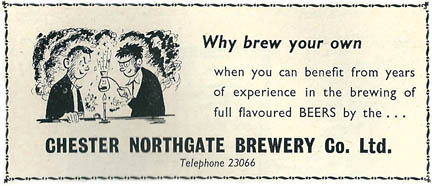 A 'Black Job' was a local term connected with the undertaking business. A 'Black Job' was a local term connected with the undertaking business.
The coming of the railway brought about the decine of the old coaching inns and, in 1856, Chester author and guide Thomas Hughes, who remembered the place in its heyday, recalled that it had been, "always full of the right sort of visitors, and seldom was a stall vacant in the immense stabling at the rear... Times are changed now; every dog has his day and doubtless every Lion too: at all events, our White Lion is neither so brisk nor so vigorous as he was of yore. The present worthy landlord is himself a retired whip, and as he rambles up and down through those noble rooms, once swarming with company, must often, we fear, look back gloomily upon the past".
The proprietors of the Cambrian Brewery, Wrexham bought the White Lion in 1840 and promptly evicted the tenant Thomas Whaley. They advertised the house as to be let (Chester Chronicle: 17th July 1840):
"White Lion Hotel Posting House, Chester. TO BE LET, with possession, on the 1st day of January next, that very Old Established and highly respectably accustomed HOTEL, replete with every convenience for the comfort and accommodation of families, having numerous sitting and bed rooms, extensive Stabling, Lock-up Coach-houses, &c. situated in Northgate-street, nearly central of the city of Chester, called the WHITE LION HOTEL, and now in the occupation of Mr. Thomas Whaley. For particulars apply to Messrs. CLARK & ORFORD, Cambrian Brewery, Wrexham".
Whaley responded with an announcement in the next issue of the Chester Chronicle (24th July 1840):
"White Lion Hotel, Chester. THOMAS WHALEY most gratefully acknowledges the very great patronage he has experienced since he entered on the above Hotel; and respectfully informs the public, that though he has received “notice to quit,” and the house, &c. is advertised to be let, he hopes to be able to open an equally commodious, if not superior Hotel, and he has no doubt that the public’s support will be continued to him.
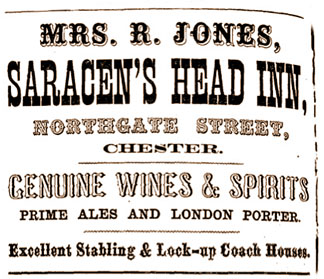 T. W. also takes this opportunity to state, that why and wherefore his tenancy of the above Hotel is to be terminated, he does not profess to explain, as he has always paid the rent punctually, and fulfilled all the duties of a tenant; but as in the advertisement notifying that it is to be Let, reference is given to Messrs. Clark and Orford, public brewers and spirit dealers, the public no doubt will readily understand, and probably appreciate the cause, particularly as T.W. has always vended wine, spirits, and malt liquor, of unimpeachable quality, which it would not have been in his power to do, if he had suffered himself to be tied to any monopolising firm". T. W. also takes this opportunity to state, that why and wherefore his tenancy of the above Hotel is to be terminated, he does not profess to explain, as he has always paid the rent punctually, and fulfilled all the duties of a tenant; but as in the advertisement notifying that it is to be Let, reference is given to Messrs. Clark and Orford, public brewers and spirit dealers, the public no doubt will readily understand, and probably appreciate the cause, particularly as T.W. has always vended wine, spirits, and malt liquor, of unimpeachable quality, which it would not have been in his power to do, if he had suffered himself to be tied to any monopolising firm".
Mr Whaley then took over the Albion Hotel in Lower Bridge Street. It is not known for how long the Cambrian Brewery owned the White Lion.
The White Lion Hotel now has its own page in our Lost Pubs of Chester galleries. We're keen to acquire more information and pictures of the place.
Next door to the White Lion, and immediately to the right of the entrance into Hamilton Place, was The Boot Inn. It was long the favourite resort of the stage coachmen who carried passengers from the staging post at the White Lion to all parts of the kingdom. (where their 'top-boots' connected with its name?) It was listed in Pigot's Directory for 1818-20 and 1828/9 when the licencee was, on both occasions, Joseph Jones and in 1840 Ellen Moss (when it was listed as The Boot Tavern). She was still there in 1850 and listed in a street directory as "Boot Inn, Ellen Moss, Fish Market". The Fish Market was near where the Dublin Packet is now (and was then). It also appears in the 1855 Slater's Directory and the 1859 Post Office Directory of Cheshire, licencee George Owens in both cases. The inn does not appear in the 1871 directory.
Another Boot Inn, established just after the Civil War in the late 1660s, is alive and well today as a Samuel Smith's house in Eastgate Row. It was not listed in the 1828 directory, whereas it was listed in 1850, so it could it be that it had a name change before 1828 and reverted to Boot Inn between 1828 and 1850.
Adjoining these was The Saracen's Head. (This was the emblem of the Warburton family, borrowed from the Crusades. It was a popular inn name during the 14th and 15th centuries). Previous to 1810 it had been called The George Inn. The landlady in 1817-40 was Mrs Mary Leet- "Mother Leet" as she was affectionately known to her regulars. Her son, who was a chemist by profession and served as a Sheriff of Chester, was among those responsible for first introducing gas street lighting into the city. In the 1780s, Simeon Leet and his wife had been the licencees of the venerable Yacht Inn in Watergate Street. Were they related? In 1857-1880 the licencee was Thomas Jones.
The patrons of the inn for many years annually banded together to form a prize to be offered at Chester Races, the Saracen's Head Handicap. The building was recorded as being used as a polling station in 1809.
In 1851, a Roman altar was unearthed in the inn's cellar.
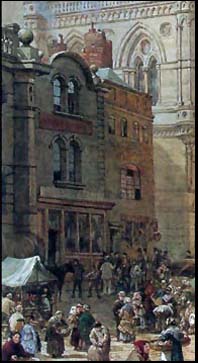 The Town Hall and Market Hall were completed by around 1869, and this meant that many of the inns and building (such as the Boot, White Lion / Fleece etc) were demolished to make way for them. However, physically in between the (then completed) Town Hall and the Market there were two buildings that were left untouched until 1882- The Market Inn on the left (immediately to the right of the Market) and The Saracens Head on the right (immediately to the left of the Town Hall). The 'extension' connecting the Town Hall and Market wasn't completed until 1882 (building work was started either the year before or that same year).
The last mention of the Saracens Head was in 1868, and the last mention of the Market Inn was in 1880. It appears that the Saracens Head was left derelict sometime after 1868, but the Market Inn survived until it was demolished for the 'extension'. The Market Inn was built by Peter Eaton, esq and replaced an earlier public house, known successively as The Star and Garter c.1770, The Golden Hart, c.1820, and The Lord Hill, c.1850. Ralph Siddel had it under this name in 1855. This comprised a public house with a dwelling house at the rear, these buildings being demolished by Peter Eaton. The Town Hall and Market Hall were completed by around 1869, and this meant that many of the inns and building (such as the Boot, White Lion / Fleece etc) were demolished to make way for them. However, physically in between the (then completed) Town Hall and the Market there were two buildings that were left untouched until 1882- The Market Inn on the left (immediately to the right of the Market) and The Saracens Head on the right (immediately to the left of the Town Hall). The 'extension' connecting the Town Hall and Market wasn't completed until 1882 (building work was started either the year before or that same year).
The last mention of the Saracens Head was in 1868, and the last mention of the Market Inn was in 1880. It appears that the Saracens Head was left derelict sometime after 1868, but the Market Inn survived until it was demolished for the 'extension'. The Market Inn was built by Peter Eaton, esq and replaced an earlier public house, known successively as The Star and Garter c.1770, The Golden Hart, c.1820, and The Lord Hill, c.1850. Ralph Siddel had it under this name in 1855. This comprised a public house with a dwelling house at the rear, these buildings being demolished by Peter Eaton.
From reading Of the Inns and Taverns of Chester by Thomas Hughes, The Lord Hill was immediately next door to the left of the Saracens Head. Ergo, the Market Inn was a later name for the Lord Hill (and Golden Hart). The Lord Hill (whose licencee in 1822 was Edward Rogers) changed its name to the Market Inn sometime between 1858 and 1864.
In 1874, a 66 year old widow, Hannah Payne, was found dead on a bench in the Market Inn- a fitting end for an habitual inebriate who had been up before the magistrates over a hundered time for drunk and disorderly behaviour.
Right: this small detail from this painting by Louise Rayner shows the Saracens Head and Market Inn before the 'extension' was built connecting the Town Hall with the Market.
Another Saracen's Head was trading somewhere in the city
in 1571 (and for at least a century after) when its landlord, John Hankey, also served as Mayor.
Not to be confused with the White Lion coaching inn above was The Old White Lion Inn, for which appeared this advertisment in Adams’s Weekly Courant on the 8th June 1784: "OLD WHITE LION INN. Edmund Warrington, Takes this Opportunity of acquainting his Friends and the Public, THAT he has just entered upon that old and commodious INN, known by the Sign of The OLD WHITE LION, near the Exchange, in this City; which he is fitting up in a neat and elegant Manner, for the Reception of Travellers and others; and where, he respectfully assures, it will be his constant Study to serve his Friends with Wines, Spirituous, and Malt Liquors, of the first Quality, and to render their Accommodations in every other Respect satisfactory and agreeable.
He with Pleasure embraces this Opportunity of expressing his most sincere and grateful Thanks for the numerous Favours conferr’d on him in the MALTING Business, and humbly hopes for their Continuance; to merit which his utmost Attention will invariably be exerted. He thinks it necessary to inform his Friends, that he has laid in a Quantity of GOOD HOME-BREW’D ALE".
Also once standing where the Market Hall would rise was an inn known in the 18th century as The Golden Hart. It was listed in Cowdroy's Directory in 1789 when the licencee was William Barlow. In 1816, its name was changed to The Lord Hill (after the hero of the Peninsula War, possibly commemorating his recent visit to Chester) and is listed as such in Pigot's Directory for 1818-20 when the licencee was Edward Rogers and in the Post Office Directory for Cheshire in 1857. In 1858, the inn's name changed again to The Great Britain. It would seem that the practise of changing pub names is by no means a modern one!
It is said that The Golden Hart had once been the house of a Roman Catholic family as, during alterations, a hidden oratory or chapel was discovered where secret services would have been during the period of Catholic persecution. In 1828 The Lord Hill's licencee was Edward Rogers, in 1850 Elizabeth Holmes.
"Give beer to those who are perishing, wine to those who are in anguish; Let them drink and forget their poverty and remember their misery no more" Proverbs, Ch 31 v 6 and 7
Somewhere in this vicinity
stood, in the 17th century, an inn by the name of The Pheasant which was run by a Nonconformist family by the name of Jollie. It was said to be a popular place of resort for travelling preachers.
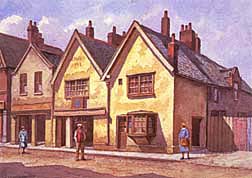 Further along the street, the Red Lion (no. 59), established
since at least 1600, was a few years ago renamed Scruffy Murphy's, an 'Irish
theme bar', but soon lost its shamrocks and reverted back to its ancient name in 2001. The former landlady of the old Lion assured us that the cellar of the pub is definitely haunted. In 1880 its landlord was Thomas G Hebblewaite. Further along the street, the Red Lion (no. 59), established
since at least 1600, was a few years ago renamed Scruffy Murphy's, an 'Irish
theme bar', but soon lost its shamrocks and reverted back to its ancient name in 2001. The former landlady of the old Lion assured us that the cellar of the pub is definitely haunted. In 1880 its landlord was Thomas G Hebblewaite.
• The Red Lion & Pheasant is listed in Cowdroy's Directory in 1782, its licencee being John Lloyd. Was this another name for today's Red Lion?
Located in the last remaining part of the vanished
12th century Lorimer's Row (a lorimer was a maker of spurs)- and dispenser
of refreshment to the traveller since at least 1494, when the first licence
to serve ale was granted, is The Blue Bell Inn (no.65, Illustrated right).
This is the oldest 'domestic' structure in Chester, and the only surviving
example of a genuine medieval inn. The braced king-post roof points to
a construction date for the present building of between 1250 and 1400, though
parts of the building may date back to the 11th century. The Bell may refer to the house's proximity to the Benedictine Abbey of St. Werburgh and the curfew bell in the bell-yard, rung every evening to warn 'strangers'
to leave the city before the gates were closed at 8pm. The Abbey's brewhouse,
close to the still-surviving 'Little Gateway' just across the street, may
also have supplied the inn's beer.
During the Civil War, the underground cellars of the old inn were put
to good use as storage for grain and other provisions, safe from the bombardment
of the besieger's guns.
A tragic story of those unsettled times gave rise to the legend of the 'Blue
Bell ghost': During the conflict, the Bell provided lodgings for many
a Loyalist soldier and his family. On the day of the Battle of Rowton Moor
(24th September 1645) a Cavalier was staying at The Bell with his young wife. He
bade her farewell, saying he hoped to return by 10 o'clock that evening and
she went to the upstairs window to see her man going off to battle. The news
from Rowton Moor was not good and the Royalists were soundly beaten. Full of trepidation,
the lady awaited his return, but alas it was not to be, her lover had been
killed. Stricken with grief she staggered down into the cellar and committed
suicide. Her name was Henrietta, and it is said that to this day, her ghost
climbs the cellar steps and walks through the upstairs restaurant to the very
window where she waited for her lover to return, all those years ago...
The unique 'cabin' extension at the front was erected "without consent" in
1684 by Elizabeth Halliwell for use as a barber's shop, which it remained
until the 1920s. During the 18th century, this extension also served as a
stage coach ticket office. You can still see the small window high on the wall where those travelling on top of the coach purchased their tickets.
By
1700, the ancient inn had become a house and shop, but reopened in 1807 as The Blue Bell in order to distinguish it from several other inns in
the vicinity with 'bell' as part of their name. It was recorded as being used as a polling station in 1809.
Pigot's Directory for the years 1818-20 show Mr T Moorcroft as licencee. In 1822-3 it was W Adams. For nearly one hundred years, from 1826, the old Blue Bell was run by the Hodgson
family, Thomas Hodgson (perhaps more than one) being in charge from 1828 to 1855 when Mary Hodgson had it, who remained until at least 1871. Margaret Hodgson ran the place next and was definitely there in 1880 (see note below) and Thomas W Hodgson in 1914. The last licensee was the wonderfully-named Thomas Pogmore Tushingham, from 1924-30 (in which year the fine picture of it above was painted by Alfred
Bennet Bamford) after which the building was bought for £1000 by the
city council, who planned to demolish it for road widening. Local people, thankfully, would
have none of it, and after a six-year fight, the Blue Bell was reprieved,
only to be threatened again in 1960. Around this time there was even a proposal
to ship the entire building to the USA! But once again, thanks to objections, it miraculously survived and for the
next 22 years was the home of Snow White's clothes shop. In 1984 it reverted to its original name and
became a traditional English restaurant.
* An article in the Cheshire Observer, 28th August 1875 mentions The Bine Bell trading in Northgate Street, run by Margaret Hodgson. As we saw above, she was running the Bue Bell at the time so the two places must be the same- or the result of a typo...
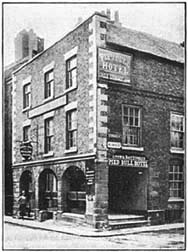 Most recently, in early 2006, the place was transformed into East Glory, an oriental restaurant and the ancient name vanished from its facade. Excellent though it was that eating and drinking should continue here after all these centuries, it seemed unforgivable that the new tenants, in their wisdom, had swept away all trace of its venerable name. We could only have hoped that poor Henrietta, the Blue Bell ghost, agreed- for how would her lost Cavalier love now be able to find his way back to her? Most recently, in early 2006, the place was transformed into East Glory, an oriental restaurant and the ancient name vanished from its facade. Excellent though it was that eating and drinking should continue here after all these centuries, it seemed unforgivable that the new tenants, in their wisdom, had swept away all trace of its venerable name. We could only have hoped that poor Henrietta, the Blue Bell ghost, agreed- for how would her lost Cavalier love now be able to find his way back to her?
But then, passing by the establshment in August 2009, we were pleasantly surprised to see the name had once again changed- to that of The Blue Bell Oriental Restaurant. (our recently having drawn the manager's attention to the story of the ghost having, of course, nothing at all to do with it!)
Read more about the ancient Blue Bell in our Inns & Brewers chapter...
• The still-thriving Pied Bull (illustrated right) had originally been built around 1473 as a private house
called Bull Mansion and was the home of the Recorder of Chester in
1533. It has also gone under the names of The Bull Inn and The Delta
Hotel. It was listed as The Py'd Bull in Cowdroy's Directory in 1789 when the licencee was James Hartley.
Today's Liverpool Arms (the 'LA') on the corner of Northgate and Water Tower Streets, was at various times known by a bewildering variety
of names: The Dog & Partridge (it was called this in 1809 when it was used as a polling station and was listed as such in Pigot's Directory in 1818 when its landlord was E Morgan) The Bull & Dog (a shoemaker called Henry Tapley is recorded as residing there in Cowdroy's Directory in 1789) and, soon afterwards, The Loggerheads Tavern. (The sign at this time depicted two stupid-looking
clowns, with underneath the motto "We Three Loggerheads Be"- the spectator,
of course, counting as one of the three! Interestingly, a pub of the same name- and bearing a similar sign- exists today on the A494 between the ancient Welsh market towns of Mold and Ruthin and seems to have given its name to the entire neighbourhood. Can anyone tell us how it came to be so named and if there is a connection?)
Cowdroy's Directory in 1789 lists The Logger-Heads in Walls Lane (an apt old name for Water Tower Street), its licencee being Benjamin Capper. In 1855 The Liverpool Tavern was in the charge of Joseph Carsley. At this time, the Shropshire Arms up the road was called The Liverpool & Shropshire House and there was another Liverpool Arms in nearby Brook Street.
By the time Charles Price was the licencee in 1871 it was called The Liverpool Arms just as it is today. In 1910, Kelly's Directory listed The Liverpool Arms under 'Water Tower Street' and gave the licencee as Thomas Bithell.
From the Chester Quarter Sessions: "Thomas Maddock and Thomas Houghton on John Almond, labourer, killed by John Meredith who broke his skull with the hilt of a sword at the house of Edward Oulton, brewer, without the Northgate, Nov 30th 1715."
"Abstainer: a weak person who yields to the temptation of denying himself a pleasure". Ambrose Bierce: The Devil's Dictionary |
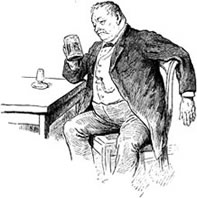
 • The Cross Keys Tavern. Mentioned in the Cheshire Sheaf as existing in 1649, and as being old even then. This inn was listed in Cowdroy's Directory in 1789 when the licencee was Vincent Evans. In 1818-22 Pigot's Directory gives the landlord as John Richards. In 1840 it was William Davies, in 1855 William Blain.
• The Cross Keys Tavern. Mentioned in the Cheshire Sheaf as existing in 1649, and as being old even then. This inn was listed in Cowdroy's Directory in 1789 when the licencee was Vincent Evans. In 1818-22 Pigot's Directory gives the landlord as John Richards. In 1840 it was William Davies, in 1855 William Blain.  • The Three Crowns Inn formerly stood where Thomas Harrison's City Club or Commercial News Rooms stands today. An inn had existed here as far back as 1272 when Richard de Knaresburgh left his daughter a shop "near the inn which was Hugh Selimon's towards the church of St. Peter's". Nothing more is heard of it for 500 years until, in 1781, The Three Crowns' landlord was Thomas Lewis, who appears in Cowdroy's Directory for that year. In 1822-3 George Foster was the proprietor. In 1855, author and guide Thomas Hughes described the inn as having an old and picturesque gable front and that its chief entrance was from Shoemaker's Row. He also remarked that it had enjoyed its finest days long before it was eventually demolished, when its sign and licence were transferred to new premises in Pepper Alley- whose name was changed to The Bridgewater Tavern in 1831.
• The Three Crowns Inn formerly stood where Thomas Harrison's City Club or Commercial News Rooms stands today. An inn had existed here as far back as 1272 when Richard de Knaresburgh left his daughter a shop "near the inn which was Hugh Selimon's towards the church of St. Peter's". Nothing more is heard of it for 500 years until, in 1781, The Three Crowns' landlord was Thomas Lewis, who appears in Cowdroy's Directory for that year. In 1822-3 George Foster was the proprietor. In 1855, author and guide Thomas Hughes described the inn as having an old and picturesque gable front and that its chief entrance was from Shoemaker's Row. He also remarked that it had enjoyed its finest days long before it was eventually demolished, when its sign and licence were transferred to new premises in Pepper Alley- whose name was changed to The Bridgewater Tavern in 1831. • The Elephant & Castle Inn: Licencee 1782 George Johnson, in 1785 Absalom Ray (Cowdroy's Directory), in 1789 Mrs Johnson, in 1818-20 Bathia Rogerson (Pigot's Directory), in 1822-3 B Goody, in 1828 George Price, in 1840 John Moult, in 1846-57 Thomas Reeves, in 1857 Thomas J Richards, in 1871-3 Peter and Ellen Dale, in 1880 Thomas Pulford.
• The Elephant & Castle Inn: Licencee 1782 George Johnson, in 1785 Absalom Ray (Cowdroy's Directory), in 1789 Mrs Johnson, in 1818-20 Bathia Rogerson (Pigot's Directory), in 1822-3 B Goody, in 1828 George Price, in 1840 John Moult, in 1846-57 Thomas Reeves, in 1857 Thomas J Richards, in 1871-3 Peter and Ellen Dale, in 1880 Thomas Pulford. Right: The title attached to this image of a rather dilapidated pub calls it 'The Northgate Arms, 1930'. Is it the same inn that, in
1856 Thomas Hughes recorded as The Northgate Tavern, that was "a step or two northward of the Golden Falcon, occupying, indeed, a portion of the house just treated of". Licencee in 1818 Robert Woodfine, in 1822-3 William Williams, in 1828 John Wynne, in 1840 Thomas Denson, in 1850 James Ruscoe, in 1855 Edward Needles, in 1857 J Read, in 1871 Thomas Bailey, in 1898-1910 Mrs Ellen Briggs. Earlier, in 1880, Slater's Directory lists it as simply The Northgate, its licencee being William Lloyd. From 1914 to at least 1920 Loftus Hughes was the landlord. It may be seen in
Right: The title attached to this image of a rather dilapidated pub calls it 'The Northgate Arms, 1930'. Is it the same inn that, in
1856 Thomas Hughes recorded as The Northgate Tavern, that was "a step or two northward of the Golden Falcon, occupying, indeed, a portion of the house just treated of". Licencee in 1818 Robert Woodfine, in 1822-3 William Williams, in 1828 John Wynne, in 1840 Thomas Denson, in 1850 James Ruscoe, in 1855 Edward Needles, in 1857 J Read, in 1871 Thomas Bailey, in 1898-1910 Mrs Ellen Briggs. Earlier, in 1880, Slater's Directory lists it as simply The Northgate, its licencee being William Lloyd. From 1914 to at least 1920 Loftus Hughes was the landlord. It may be seen in 
 • The Grosvenor Arms. (no 132, east side, next to the
• The Grosvenor Arms. (no 132, east side, next to the 

 • The Muggeries (illustrated left) was a previous ale house on this site. The gentleman in the photograph is Mr William Higginson who was licencee from 1898 to 1905. Standing with him is Miss M Campbell who ran a cake shop above The Muggeries. William left here for The Duke of York in Frodsham Street in 1906 and then, in 1910, to the
• The Muggeries (illustrated left) was a previous ale house on this site. The gentleman in the photograph is Mr William Higginson who was licencee from 1898 to 1905. Standing with him is Miss M Campbell who ran a cake shop above The Muggeries. William left here for The Duke of York in Frodsham Street in 1906 and then, in 1910, to the 
 A 'Black Job' was a local term connected with the undertaking business.
A 'Black Job' was a local term connected with the undertaking business. T. W. also takes this opportunity to state, that why and wherefore his tenancy of the above Hotel is to be terminated, he does not profess to explain, as he has always paid the rent punctually, and fulfilled all the duties of a tenant; but as in the advertisement notifying that it is to be Let, reference is given to Messrs. Clark and Orford, public brewers and spirit dealers, the public no doubt will readily understand, and probably appreciate the cause, particularly as T.W. has always vended wine, spirits, and malt liquor, of unimpeachable quality, which it would not have been in his power to do, if he had suffered himself to be tied to any monopolising firm".
T. W. also takes this opportunity to state, that why and wherefore his tenancy of the above Hotel is to be terminated, he does not profess to explain, as he has always paid the rent punctually, and fulfilled all the duties of a tenant; but as in the advertisement notifying that it is to be Let, reference is given to Messrs. Clark and Orford, public brewers and spirit dealers, the public no doubt will readily understand, and probably appreciate the cause, particularly as T.W. has always vended wine, spirits, and malt liquor, of unimpeachable quality, which it would not have been in his power to do, if he had suffered himself to be tied to any monopolising firm".
 Further along the street, the Red Lion (no. 59), established
since at least 1600, was a few years ago renamed Scruffy Murphy's, an 'Irish
theme bar', but soon lost its shamrocks and reverted back to its ancient name in 2001. The former landlady of the old Lion assured us that the cellar of the pub is definitely haunted. In 1880 its landlord was Thomas G Hebblewaite.
Further along the street, the Red Lion (no. 59), established
since at least 1600, was a few years ago renamed Scruffy Murphy's, an 'Irish
theme bar', but soon lost its shamrocks and reverted back to its ancient name in 2001. The former landlady of the old Lion assured us that the cellar of the pub is definitely haunted. In 1880 its landlord was Thomas G Hebblewaite. Most recently, in early 2006, the place was transformed into East Glory, an oriental restaurant and the ancient name vanished from its facade. Excellent though it was that eating and drinking should continue here after all these centuries, it seemed unforgivable that the new tenants, in their wisdom, had swept away all trace of its venerable name. We could only have hoped that poor Henrietta, the Blue Bell ghost, agreed- for how would her lost Cavalier love now be able to find his way back to her?
Most recently, in early 2006, the place was transformed into East Glory, an oriental restaurant and the ancient name vanished from its facade. Excellent though it was that eating and drinking should continue here after all these centuries, it seemed unforgivable that the new tenants, in their wisdom, had swept away all trace of its venerable name. We could only have hoped that poor Henrietta, the Blue Bell ghost, agreed- for how would her lost Cavalier love now be able to find his way back to her?